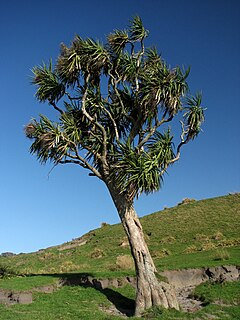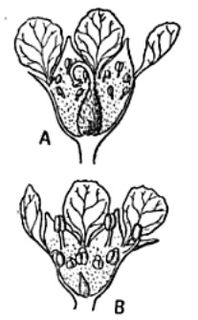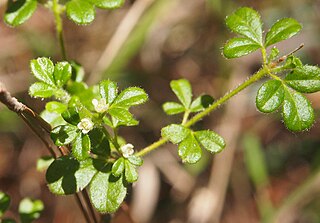
Cordyline australis, commonly known as the cabbage tree or cabbage-palm, is a widely branched monocot tree endemic to New Zealand.

Cordyline fruticosa is an evergreen flowering plant in the family Asparagaceae. The plant is of great cultural importance to the traditional animistic religions of Austronesian and Papuan peoples of the Pacific Islands, New Zealand, Island Southeast Asia, and Papua New Guinea. It is also cultivated for food, traditional medicine, and as an ornamental for its variously colored leaves. It is identified by a wide variety of common names, including ti plant, palm lily, cabbage palm.

Cordyline is a genus of about 15 species of woody monocotyledonous flowering plants in family Asparagaceae, subfamily Lomandroideae. The subfamily has previously been treated as a separate family Laxmanniaceae, or Lomandraceae. Other authors have placed the genus in the Agavaceae. Cordyline is native to the western Pacific Ocean region, from New Zealand, eastern Australia, southeastern Asia and Polynesia, with one species found in southeastern South America.

Arbutus xalapensis, commonly known as the Texas madrone, naked Indian tree or Texas madroño, is a species of flowering plant in the heather family. It is native to Central America, the southwestern United States, and throughout Mexico. It is found in canyons and mountains, on rocky plains, and in oak woodlands, at altitudes of up to 3,000 m in the south of the range, but lower, down to 600 m in the north of the range.

Eschscholzia minutiflora is a species of poppy known by the common name pygmy poppy.

Cordyline congesta, commonly known as narrow-leaved palm lily is an evergreen Australian plant. A rare shrub to 3 metres tall found on the margins of rainforest, and in riverine scrub and moist gullies in eucalyptus forest. Growing north from the Clarence River, New South Wales.

Cordyline stricta, known as the Slender Palm Lily, or Narrow-leaved Palm Lily is an evergreen Australian plant. A shrub to 5 metres tall found in wet sclerophyll forest and rainforest, usually on the coastal lowlands. From near Bilpin, New South Wales further north to Queensland. C. stricta has become naturalised in Victoria.

Cordyline pumilio, commonly known as the dwarf cabbage tree, pygmy cabbage tree or by its Māori names tī koraha or tī rauriki, is a narrow-leaved monocot shrub endemic to New Zealand. It usually grows up to 1 metre tall, although rare examples of 2 metres tall have been reported. It has long leaves and can easily be mistaken for a grass or a sedge. C. pumilio grows in the north of the North Island from North Cape at 34°S to Kawhia and Opotiki at about 38°S, generally under light forest and scrub. It was cultivated by Māori as a source of carbohydrate and used as a relish to sweeten less palatable foods.

Prunus minutiflora, called the Texas almond, is a shrub native to Texas and northern Mexico.
Verticordia minutiflora is a flowering plant in the myrtle family, Myrtaceae and is endemic to the south-west of Western Australia. It is a bushy shrub with small, crowded, cylindrical leaves and groups of white to pale pink flowers in summer and autumn. As suggested by its botanical name, it has the smallest flowers of any verticordia.
Verticordia vicinella is a flowering plant in the myrtle family, Myrtaceae and is endemic to the south-west of Western Australia. It is a shrub with narrow leaves and groups of small, scented, pink or pale yellow flowers, growing near Esperance and in the Cape Arid National Park.
Verticordia wonganensis is a flowering plant in the myrtle family, Myrtaceae and is endemic to the south-west of Western Australia. It is a shrub which grows near Wongan Hills and has a single main stem, small leaves and spike-like groups of large, pink, feathery flowers.
Grevillea minutiflora is a shrub of the genus Grevillea native to a small area in the Wheatbelt region of Western Australia.

Zieria minutiflora, commonly known as twiggy zieria, is a plant in the citrus family Rutaceae and is endemic to eastern Australia. It is a small, erect, twiggy shrub with leaves composed of three leaflets, and clusters of small white flowers with four petals and four stamens. It usually grows as an understorey shrub in eucalypt woodland.

Leucospermum innovans is an upright evergreen shrub with many pustules growing on the lower branches, wedge-shaped leaves, and oval, flower heads that are yellow on the outside, but with scarlet stripes on the inside of the perianth claws, with long styles sticking far beyond the perianths, jointly giving the impression of a pincushion. It is called Pondoland pincushion or Transkei pincushion in English. Flowers occur on and off between July and December, but flowering peaks in September and October.

Leucospermum vestitum is an evergreen, upright to more or less spreading shrub of up to 2½ m (9 ft) high and wide from the family Proteaceae. It has greyish, seated, oblong, 2–3 inch long leaves with two to four teeth near the tip and large, showy two-toned flower heads that are bright orange at first by and age to brilliant crimson. From the center of the perianth emerge long styles, higher up bending towards the center of the head, that jointly give the impression of a pincushion. It is called silky-haired pincushion in English and bergluisie in Afrikaans. It can be found in the Western Cape province of South Africa, and flowers from July until January, peaking October and November.

Protea pendula, also known as the nodding sugarbush or arid sugarbush, is a flowering plant of the genus Protea, in the family Proteaceae, which is only found growing in the wild in the Cape Region of South Africa. In the Afrikaans language it is known as knikkopsuikerbossie or ondersteboknopprotea.
Goodenia micrantha is a species of flowering plant in the family Goodeniaceae and is endemic to south-western Australia. It is a prostrate to ascending herb with linear leaves at the base of the plant and racemes of small, yellowish flowers with a brownish centre.
Goodenia minutiflora is a species of flowering plant in the family Goodeniaceae and is endemic to northern Australia. It is an annual herb with linear to lance-shaped leaves, and loose groups of tiny white or purplish flowers.
Goodenia neogoodenia is a species of flowering plant in the family Goodeniaceae and is endemic to the western part of Western Australia. It is a prostrate, annual herb with round to heart-shaped or rhombic leaves and racemes or spikes of small, brownish flowers.












